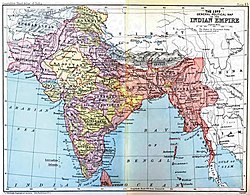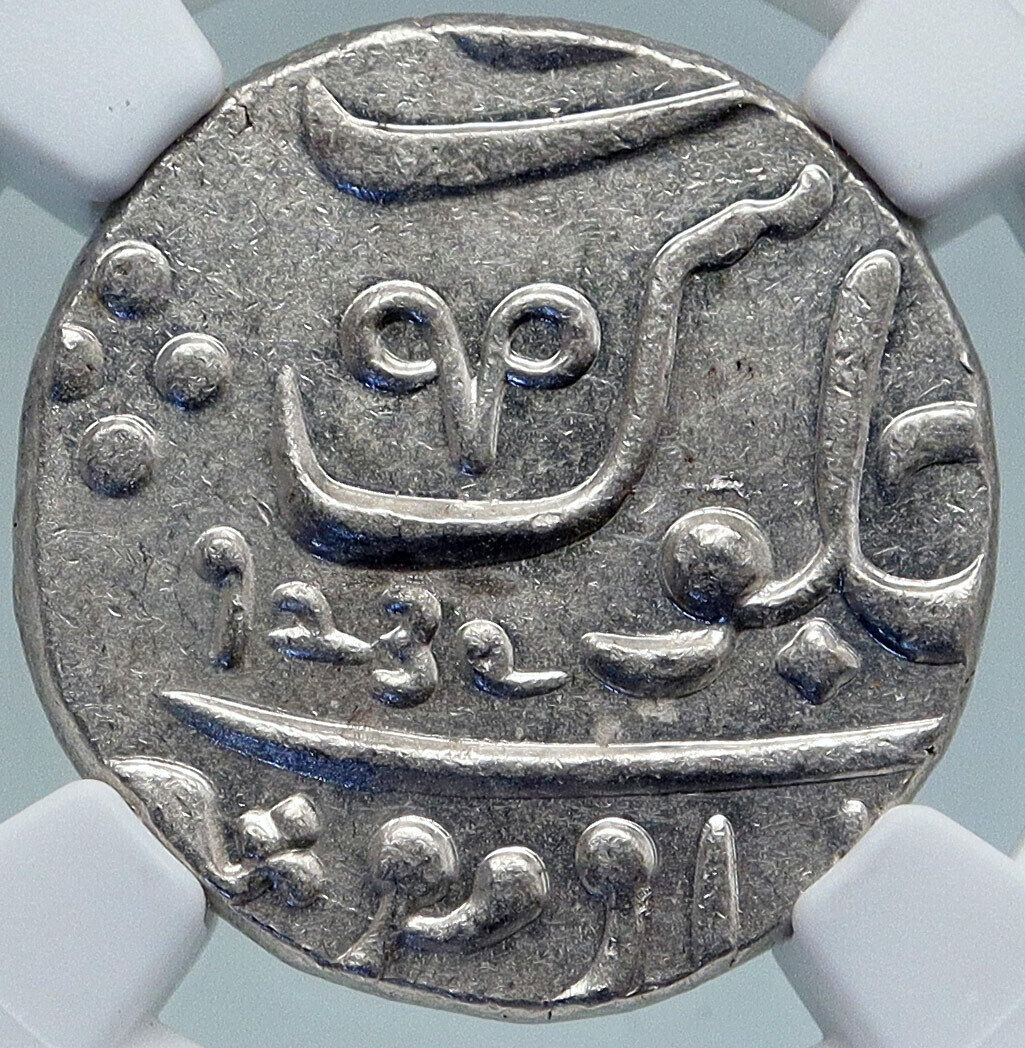|
British India under Victoria – Queen: 20 June 1837 – 22 January 1901
1862 Silver Rupee 30mm (11.64 grams) 0.917 Silver (0.3438 oz. ASW)
Reference: KM# 473.1 (1862)
VICTORIA QUEEN, Victoria facing left.
ONE RUPEE INDIA, Value within wreath.
You are bidding on the exact item pictured, provided with a Certificate of Authenticity and Lifetime Guarantee of Authenticity.
 The Provinces of India, earlier Presidencies of British India and still earlier, Presidency towns, were the administrative divisions of British governance in the Indian subcontinent. Collectively, they have been called British India. In one form or another, they existed between 1612 and 1947, conventionally divided into three historical periods: The Provinces of India, earlier Presidencies of British India and still earlier, Presidency towns, were the administrative divisions of British governance in the Indian subcontinent. Collectively, they have been called British India. In one form or another, they existed between 1612 and 1947, conventionally divided into three historical periods:
- Between 1612 and 1757 the East India Company set up “factories” (trading posts) in several locations, mostly in coastal India, with the consent of the Mughal emperors, Maratha empire or local rulers. Its rivals were the merchant trading companies of Portugal, Denmark, the Netherlands, and France. By the mid-18th century three Presidency towns: Madras, Bombay and Calcutta, had grown in size.
- During the period of Company rule in India, 1757–1858, the Company gradually acquired sovereignty over large parts of India, now called “Presidencies”. However, it also increasingly came under British government oversight, in effect sharing sovereignty with the Crown. At the same time, it gradually lost its mercantile privileges.
- Following the Indian Rebellion of 1857 the company’s remaining powers were transferred to the Crown. Under the British Raj (1858–1947), administrative boundaries were extended to include a few other British-administered regions, such as Upper Burma. Increasingly, however, the unwieldy presidencies were broken up into “Provinces”.
In this sense, “British India” did not include the princely states directly ruled by Indian princes, though under a close eye from the British authorities. At Indian Independence in 1947 there were over 500 of these (most extremely small, but with a few very large ones), making up 40% of the area and 23% of the population of the whole British Raj.
d the independence of Siam. All his reforms were dedicated to ensuring Siam’s independence given the increasing encroachment of Western powers, so that Chulalongkorn earned the epithet Phra Piya Maharat (พระปิยมหาราช, the Great Beloved King).
At the end of his regency, Si Suriyawonse was raised to Somdet Chao Phraya, the highest title a noble could attain. Si Suriyawongse was the most powerful noble of the 19th century. His family, the House of Bunnag, was a powerful aristocratic dynasty of Persian descent. It dominated Siamese politics since the reign of Rama I. Chulalongkorn then married four of his half-sisters, all daughters of Mongkut: Savang Vadhana, Saovabha, and Sunandha (Mongkut with concubine Piam), and Sukumalmarsri (Monkut with concubine Samli).
Chulalongkorn’s first reform was to establish the “Auditory Office” (Th: หอรัษฎากรพิพัฒน์), solely responsible for tax collection, to replace corrupt tax collectors. As tax collectors had been under the aegis of various nobles and thus a source of their wealth, this reform caused great consternation among the nobility, especially the Front Palace. From the time of King Mongkut, the Front Palace had been the equivalent of a “second king”, with one-third of national revenue allocated to it. Prince Yingyot of the Front Palace was known to be on friendly terms with many Britons, at a time when Siamese relations with the British Empire were tense.
In 1874, Chulalongkorn established the Council of State as a legislative body and a privy council as his personal advisory board based on the British privy council. Council members were appointed by the monarch.
Chulalongkorn was the first Siamese king to send royal princes to Europe to be educated. In 19th century Europe, nationalism flourished and there were calls for more liberty. The princes were influenced by the liberal notions of democracy and elections they encountered in republics like France and constitutional monarchies like the United Kingdom.
In 1884 (year 103 of the Rattakosin Era), Siamese officials in Europe warned Chulalongkorn of possible threats to Siamese independence from the European powers. They advised that Siam should be reformed like Meiji Japan and that Siam should become a constitutional monarchy. Chulalongkorn demurred, stating that the time was not ripe and that he himself was making reforms.
Throughout Chulalongkorn’s reign, writers with radical ideas had their works published for the first time. The most notable ones included Thianwan Wannapho, who had been imprisoned for 17 years and from prison produced many works criticizing traditional Siamese society.
In 1608, Mughal authorities allowed the English East India Company to establish a small trading settlement at Surat (now in the state of Gujarat), and this became the company’s first headquarters town. It was followed in 1611 by a permanent factory at Machilipatnam on the Coromandel Coast, and in 1612 the company joined other already established European trading companies in Bengal in trade. However, the power of the Mughal Empire declined from 1707, first at the hands of the Marathas and later due to invasion from Persia (1739) and Afghanistan (1761); after the East India Company’s victories at the Battle of Plassey (1757) and Battle of Buxar (1764)—both within the Bengal Presidency established in 1765—and the abolition of local rule (Nizamat) in Bengal in 1793, the Company gradually began to formally expand its territories across India. By the mid-19th century, and after the three Anglo-Maratha Wars the East India Company had become the paramount political and military power in south Asia, its territory held in trust for the British Crown.
Company rule in Bengal (after 1793) was terminated by the Government of India Act 1858, following the events of the Bengal Rebellion of 1857. Henceforth known as British India, it was thereafter directly ruled as a colonial possession of the United Kingdom, and India was officially known after 1876 as the Indian Empire. India was divided into British India, regions that were directly administered by the British, with Acts established and passed in British Parliament, and the Princely States, ruled by local rulers of different ethnic backgrounds. These rulers were allowed a measure of internal autonomy in exchange for recognition of British suzerainty. British India constituted a significant portion of India both in area and population; in 1910, for example, it covered approximately 54% of the area and included over 77% of the population. In addition, there were Portuguese and French exclaves in India. Independence from British rule was achieved in 1947 with the formation of two nations, the Dominions of India and Pakistan, the latter including East Bengal, present-day Bangladesh.
The term British India also applied to Burma for a shorter time period: beginning in 1824, a small part of Burma, and by 1886, almost two thirds of Burma had been made part of British India. This arrangement lasted until 1937, when Burma was reorganized as a separate British colony. British India did not apply to other countries in the region, such as Sri Lanka (then Ceylon), which was a British Crown colony, or the Maldive Islands, which were a British protectorate. At its greatest extent, in the early 20th century, the territory of British India extended as far as the frontiers of Persia in the west; Afghanistan in the northwest; Nepal in the north, Tibet in the northeast; and China, French Indochina and Siam in the east. It also included the Aden Province in the Arabian Peninsula.
|





 The Provinces of India, earlier Presidencies of British India and still earlier, Presidency towns, were the administrative divisions of British governance in the Indian subcontinent. Collectively, they have been called British India. In one form or another, they existed between 1612 and 1947, conventionally divided into three historical periods:
The Provinces of India, earlier Presidencies of British India and still earlier, Presidency towns, were the administrative divisions of British governance in the Indian subcontinent. Collectively, they have been called British India. In one form or another, they existed between 1612 and 1947, conventionally divided into three historical periods:




